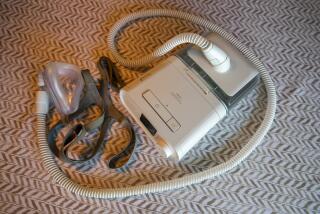Replacing Heart Device Found Risky
- Share via
Surgery to replace potentially defective heart defibrillators carries an unexpectedly high rate of serious complications, including death, according to a study published today.
The research in the Journal of the American Medical Assn. showed that one in 50 patients needed to have the replacement device removed because of severe postoperative infections.
Dr. Andrew D. Krahn of Canada’s University of Western Ontario and one of the study’s authors said the overall complication rate was three to five times higher than expected. “We were absolutely surprised by these numbers,” he said.
Two other studies in the journal tracked the annual malfunction rate of defibrillators, which started rising in the late 1990s as the devices became more complex but began falling in 2002. It is now less than 1%.
Taken together, the three studies paint the fullest picture yet of the risks to patients of removing or retaining a defibrillator recalled by its manufacturer.
The reports come amid controversy about defibrillators, devices used to steady heartbeats or jolt the hearts of those in cardiac arrest.
Medtronic Inc. and Guidant Corp. last year issued warnings about flaws in their defibrillators.
Guidant also faces a Justice Department inquiry related to its safety alerts. The company told the Food and Drug Administration about electrical problems with its Ventak Prizm 2 DR device but did not give that information to patients and doctors.
About 135,000 patients receive a defibrillator each year to help prevent a sudden heart attack. The devices differ from pacemakers, which are older, less complex devices that use tiny currents of electricity to regulate slow heartbeats.
Krahn said doctors had long believed the complication rate for defibrillator surgery ranged from 1% to 2%, about the same as for routine operations.
But his study of 533 patients at 17 Canadian medical centers who elected to have their defibrillators replaced after a safety recall found that 43 patients, or 8.1% of the total, suffered infections and other complications within three months of their surgeries. Of those, 31 patients, or 5.8%, had severe complications and two died. Ten patients with bad infections needed to have replacement devices removed.
The study was the first to examine the rate of complications associated with replacing defibrillators, a procedure typically performed every five to seven years to replace batteries.
Krahn couldn’t explain why the complication rate was so high. The study suggests patients and their doctors should weigh the risks of complications before removing defibrillators after a safety alert, he said.
“When you start changing out a device with a risk of problems well under 1%, you could be causing more complications than you are saving,” said Dr. Anne B. Curtis, president of the Heart Rhythm Society and a University of South Florida professor.
The second study examined cases of malfunctions requiring replacement that were reported to the FDA from 1990 to 2002. Researchers found that as the devices became smaller and more complex, the malfunction rate rose to a peak of 36.4 per 1,000 in 2001, or nearly 4%, from a low of 7.9 per 1,000 in 1996, less than 1%.
The average malfunction rate of defibrillators during the 12 years of the study was more than four times that of pacemakers over the same period. Results of the study, conducted by Dr. William H. Maisel of Beth Israel Deaconess Medical Center in Boston and researchers from the FDA, were first reported at a medical meeting in September.
The third study, conducted by Maisel, looked at malfunctions reported to patient registries in the United States and Demark from 1988 to 2004. As in the FDA study, the malfunction rate peaked in 2001 but fell to 7.4 per 1,000 in 2004, less than 1%.
Although the drop was encouraging, Maisel said, defibrillators were not as reliable as pacemakers, which had a malfunction rate of 1.3 per 1,000 in 2004. He said patients with the devices should be monitored.





